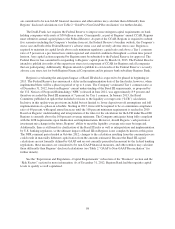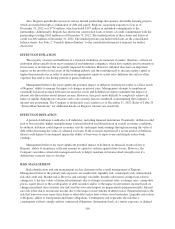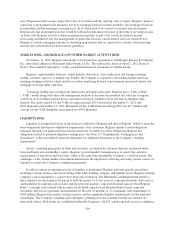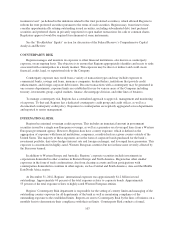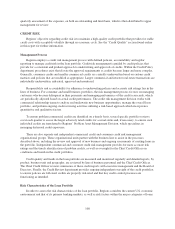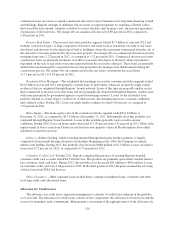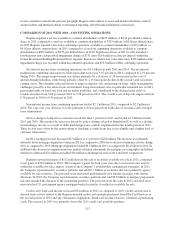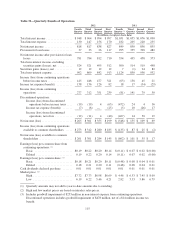Regions Bank 2012 Annual Report Download - page 122
Download and view the complete annual report
Please find page 122 of the 2012 Regions Bank annual report below. You can navigate through the pages in the report by either clicking on the pages listed below, or by using the keyword search tool below to find specific information within the annual report.the program did not have a significant impact on liquidity. The Dodd-Frank Act permanently increased the FDIC
coverage limit to $250,000. As a result of the Dodd-Frank Act, effective December 31, 2010, unlimited coverage
for non-interest bearing demand transaction accounts was provided until January 1, 2013. In early 2013, non-
interest bearing transaction accounts have declined, but the overall impact to deposit balances and liquidity has
not been significant and is within expectations.
Regulation Q prohibited banks from paying interest on business checking accounts in accordance with the
Glass-Steagall Act of 1933. However, the Dodd-Frank Act repealed Regulation Q. In July 2011, financial
institutions, such as Regions, were allowed to offer interest on corporate checking accounts. Regions responded
to these changes by enhancing its existing core interest-bearing products. However, due to the low interest rate
environment and unlimited FDIC insurance available on non-interest bearing balances until January 1, 2013, the
Company has not experienced, nor does it anticipate experiencing significant migration of business customer
balances from non-interest bearing accounts to an interest-bearing account.
Due to the potential for uncertainty and inconsistency in the unsecured funding markets, Regions has been
maintaining higher levels of cash liquidity by depositing excess cash with the Federal Reserve Bank, which is the
primary component of the balance sheet line item, “interest-bearing deposits in other banks.” At December 31,
2012, Regions had over $3.5 billion in excess cash on deposit with the Federal Reserve. Regions’ borrowing
availability with the Federal Reserve Bank as of December 31, 2012, based on assets available for collateral at
that date, was $19.6 billion.
Regions periodically accesses funding markets through sales of securities with agreements to repurchase.
Repurchase agreements are also offered through a commercial banking sweep product as a short-term investment
opportunity for customers. All such arrangements are considered typical of the banking industry and are
accounted for as borrowings.
Regions’ financing arrangement with the FHLB adds additional flexibility in managing its liquidity position.
As of December 31, 2012, Regions’ borrowing availability from the FHLB totaled $6.7 billion. FHLB borrowing
capacity is contingent on the amount of collateral pledged to the FHLB. Regions Bank and its subsidiaries have
pledged certain residential first mortgage loans on one-to-four family dwellings and home equity lines of credit
as collateral for the FHLB advances outstanding. Additionally, investment in FHLB stock is required in relation
to the level of outstanding borrowings. Regions held $73 million in FHLB stock at December 31, 2012. The
FHLB has been and is expected to continue to be a reliable and economical source of funding.
In February 2010, Regions filed a shelf registration statement with the U.S. Securities and Exchange
Commission. This shelf registration does not have a capacity limit and can be utilized by Regions to issue
various debt and/or equity securities. The registration statement will expire in February 2013. Regions expects to
file a new shelf registration statement prior to the expiration of the current shelf registration statement. In 2012,
Regions issued from the shelf 153 million shares of common stock with a par value $0.01 per share at $5.90 a
share as well as 20 million depositary shares each representing a 1/40th ownership interest in the Company’s
6.375% Non-Cumulative Perpetual Preferred Stock, Series A, with a $1.00 par value.
Regions’ Bank Note program allows Regions Bank to issue up to $20 billion aggregate principal amount of
bank notes outstanding at any one time. No issuances have been made under this program as of December 31,
2012. Notes issued under the program may be senior notes with maturities from 30 days to 15 years and
subordinated notes with maturities from 5 years to 30 years. These notes are not deposits and they are not insured
or guaranteed by the FDIC.
On December 3, 2012, following a notice by the Federal Reserve of proposed rulemaking which would
phase-out the Tier 1 capital treatment of the trust preferred securities, Regions redeemed approximately
$345 million of issued and outstanding 8.875% Trust Preferred Securities issued by Regions Financing Trust III.
Regions determined that the Federal Reserve’s approval for publication of the notice constituted a “capital
106




